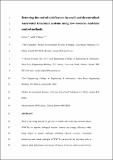| dc.contributor.author | Fox, S. | |
| dc.contributor.author | Clifford, Eoghan | |
| dc.date.accessioned | 2019-09-03T11:39:01Z | |
| dc.date.available | 2019-09-03T11:39:01Z | |
| dc.date.issued | 2018-06-12 | |
| dc.identifier.citation | Fox, S., & Clifford, E. (2018). Detecting the End of Nitrification in Small and Decentralized Wastewater Treatment Systems Using Low-Resource Real-Time Control Methods. Journal of Environmental Engineering, 144(8), 04018069. doi: 10.1061/(ASCE)EE.1943-7870.0001404 | en_IE |
| dc.identifier.issn | 0733-9372 | |
| dc.identifier.issn | 1943-7870 | |
| dc.identifier.uri | http://hdl.handle.net/10379/15374 | |
| dc.description.abstract | There is increasing demand on operators of small-scale wastewater treatment plants (WWTPs) to improve biological nutrient removal and energy efficiency while being subject to unique challenges, including reduced resources. Automated monitoring and control strategies of WWTPs can provide the necessary tools to improve plant performance and energy efficiency. However, online sensors for key parameters such as ammonium can require excessive maintenance, are unreliable unless frequently maintained, and often are not affordable. In addition, control techniques such as machine learning may not be financially or technically compatible within the constraints of small-scale WWTPs. This study analyzes the use of low-cost, reliable surrogate sensors in association with inexpensive and robust programmable logistic controllers to improve WWTP performance and energy efficiency through automation. The paper presents three novel methodologies for control of batch WWTPs using pH and oxidation reduction potential (ORP) trends. Applying and optimizing these methodologies enabled an average reduction in cycle time and energy consumption of 60 and 43%, respectively, when compared to the fixed-time treatment cycle and an average effluent ammonium concentration of 1.9mg/L. The automated system proposed has significant potential to enhance the performance of small-scale WWTPs in terms of environmental compliance and energy consumption. | en_IE |
| dc.description.sponsorship | The authors wish to acknowledge the support received from the Irish Research Council, Molloy Environmental Systems (EPSPG/2011/53) and Enterprise Ireland (IP/2010/0084). | en_IE |
| dc.format | application/pdf | en_IE |
| dc.language.iso | en | en_IE |
| dc.publisher | American Society of Civil Engineers | en_IE |
| dc.relation.ispartof | Journal Of Environmental Engineering-Asce | en |
| dc.rights | Attribution-NonCommercial-NoDerivs 3.0 Ireland | |
| dc.rights.uri | https://creativecommons.org/licenses/by-nc-nd/3.0/ie/ | |
| dc.subject | SEQUENCING BATCH-REACTOR | en_IE |
| dc.subject | BIOLOGICAL NITROGEN REMOVAL | en_IE |
| dc.subject | NUTRIENT REMOVAL | en_IE |
| dc.subject | CONTROL STRATEGY | en_IE |
| dc.subject | NEURAL-NETWORKS | en_IE |
| dc.subject | ORP | en_IE |
| dc.subject | PH | en_IE |
| dc.subject | AERATION | en_IE |
| dc.subject | REDUCTION | en_IE |
| dc.subject | PROFILES | en_IE |
| dc.title | Detecting the end of nitrification in small and decentralized wastewater treatment systems using low-resource real-time control methods | en_IE |
| dc.type | Article | en_IE |
| dc.date.updated | 2019-08-13T16:24:59Z | |
| dc.identifier.doi | 10.1061/(ASCE)EE.1943-7870.0001404 | |
| dc.local.publishedsource | https://doi.org/10.1061/(ASCE)EE.1943-7870.0001404 | en_IE |
| dc.description.peer-reviewed | peer-reviewed | |
| dc.contributor.funder | Irish Research Council | en_IE |
| dc.contributor.funder | Enterprise Ireland | en_IE |
| dc.internal.rssid | 17247694 | |
| dc.local.contact | Eoghan Clifford, Room 1035, Alice Perry Engineering Building, Nui Galway, Galway. 2219 Email: eoghan.clifford@nuigalway.ie | |
| dc.local.copyrightchecked | Yes | |
| dc.local.version | ACCEPTED | |
| nui.item.downloads | 304 | |


